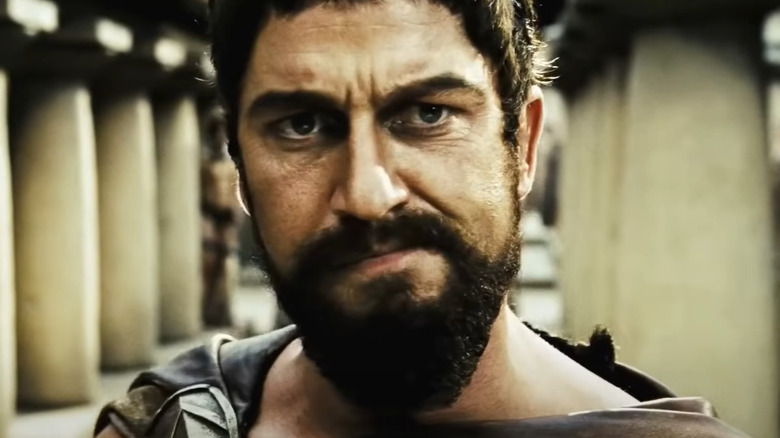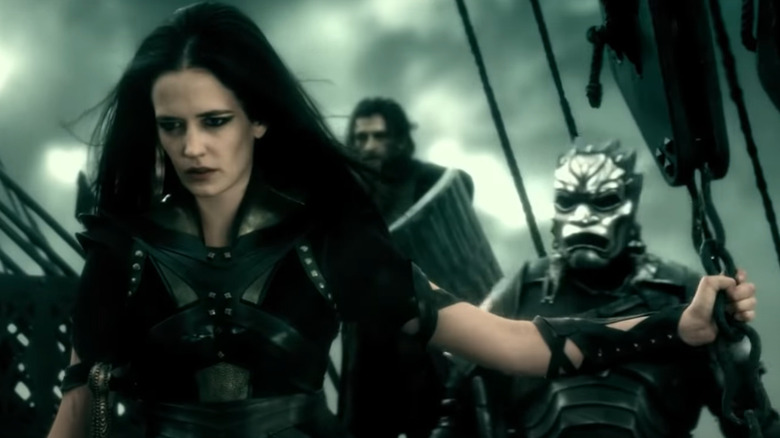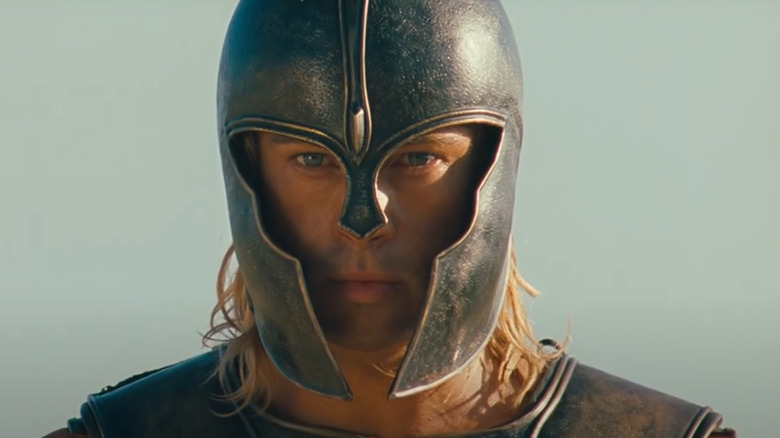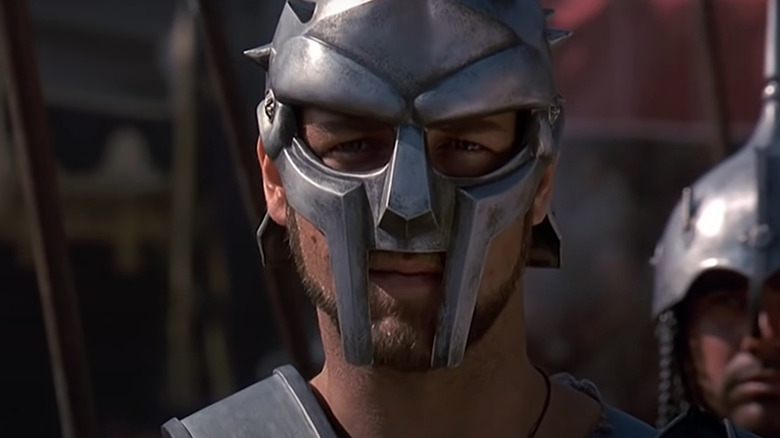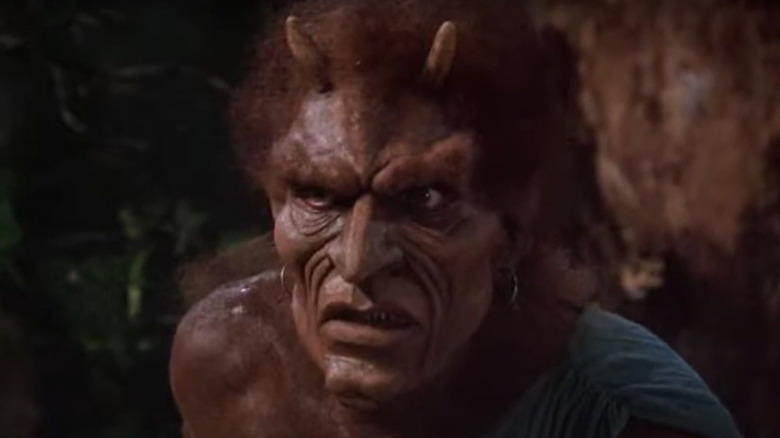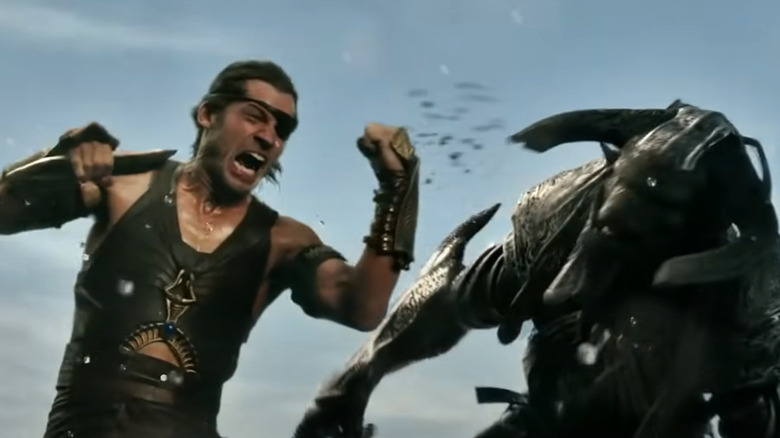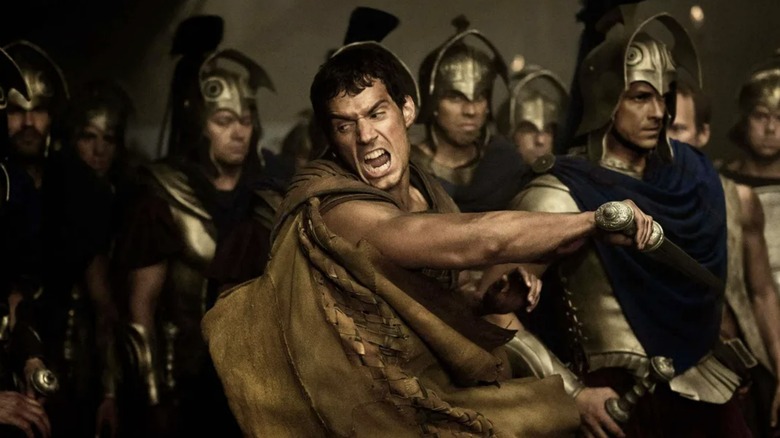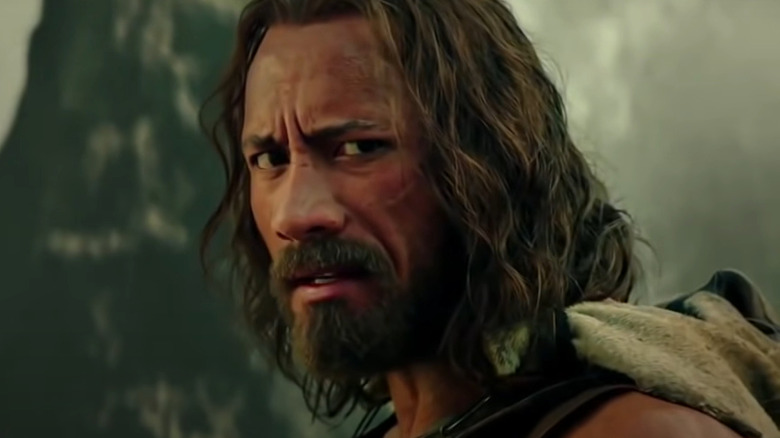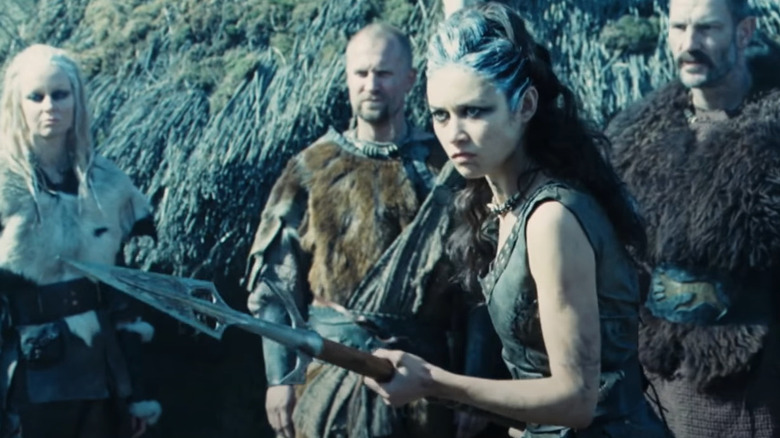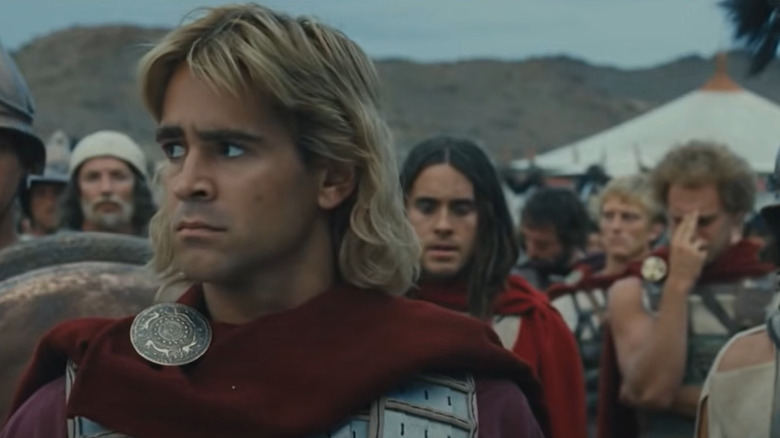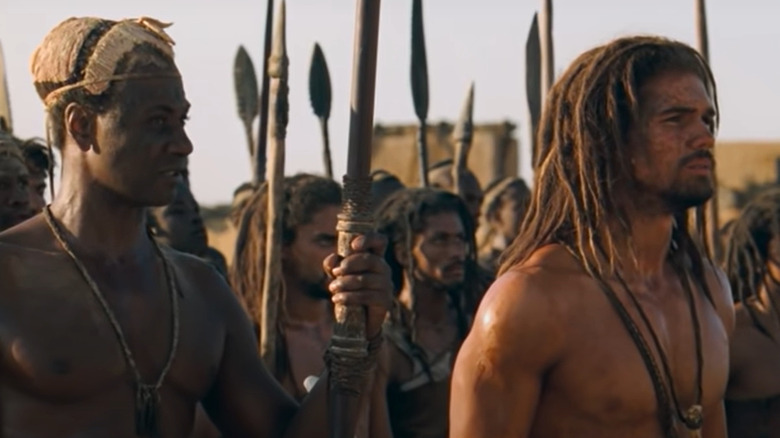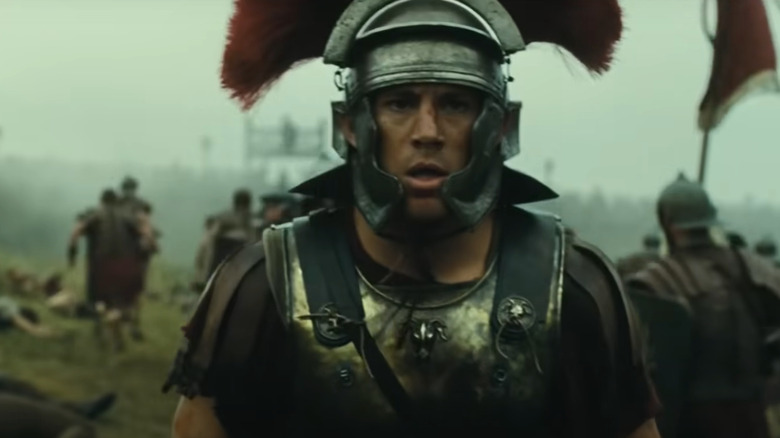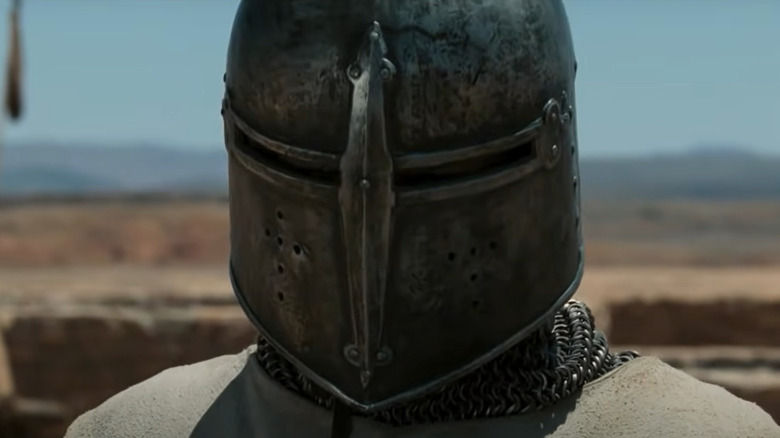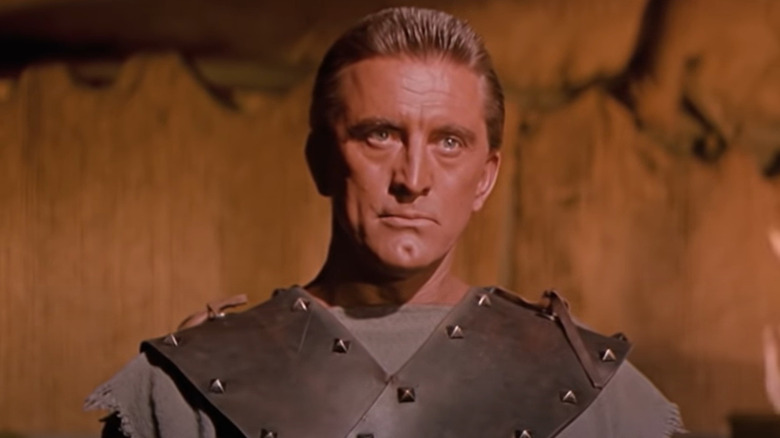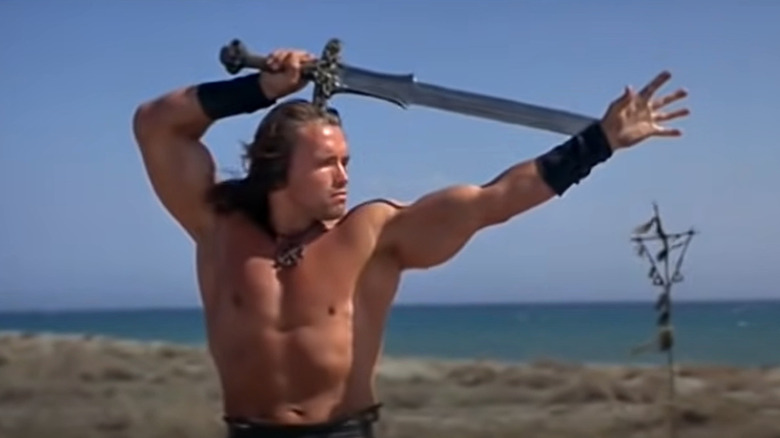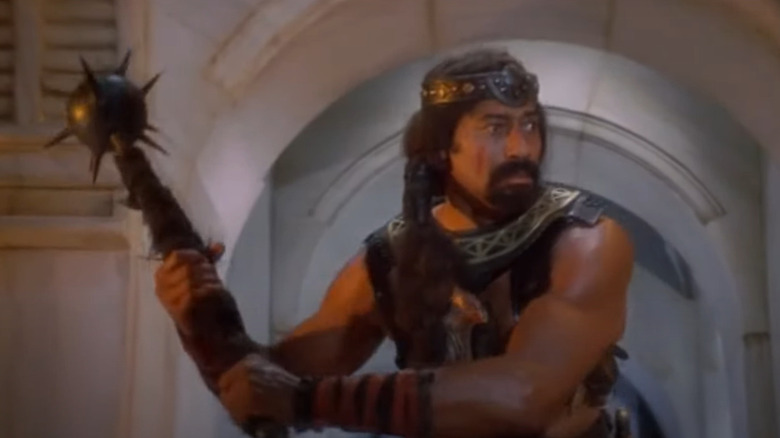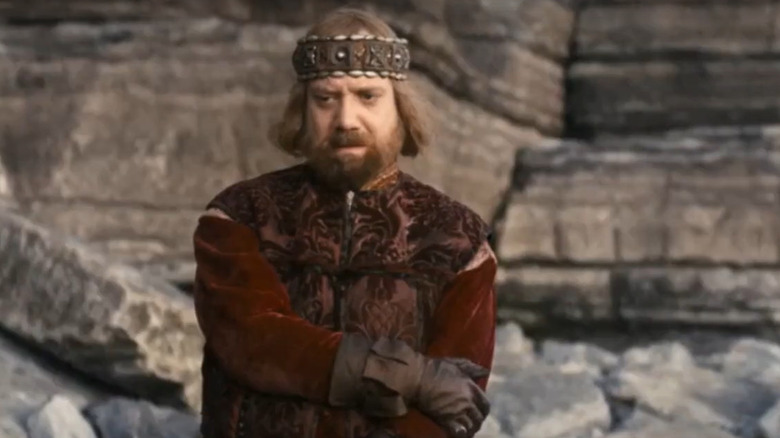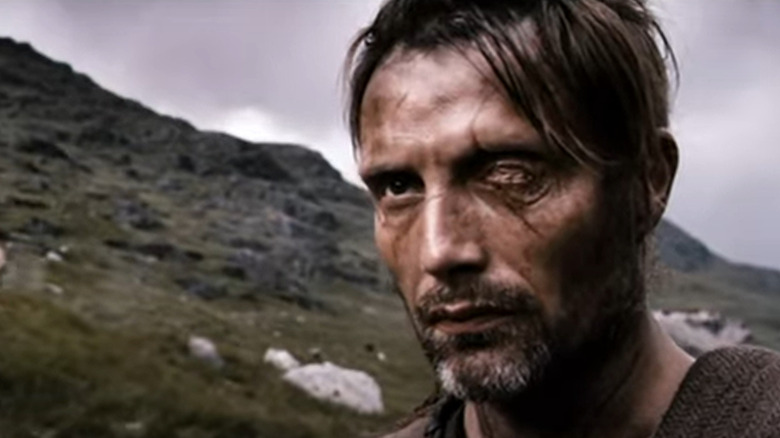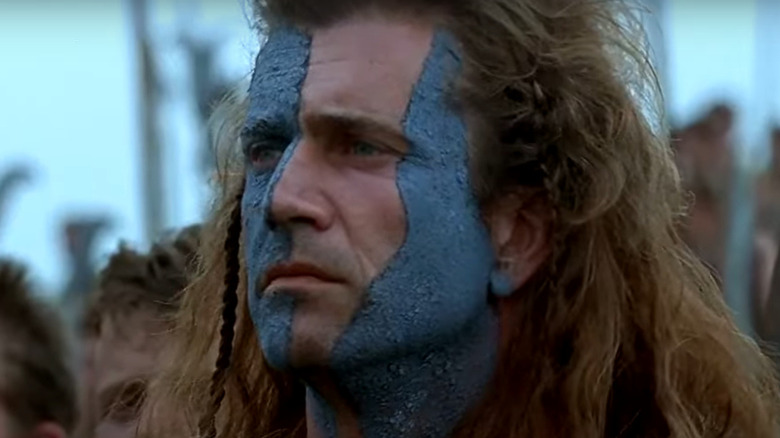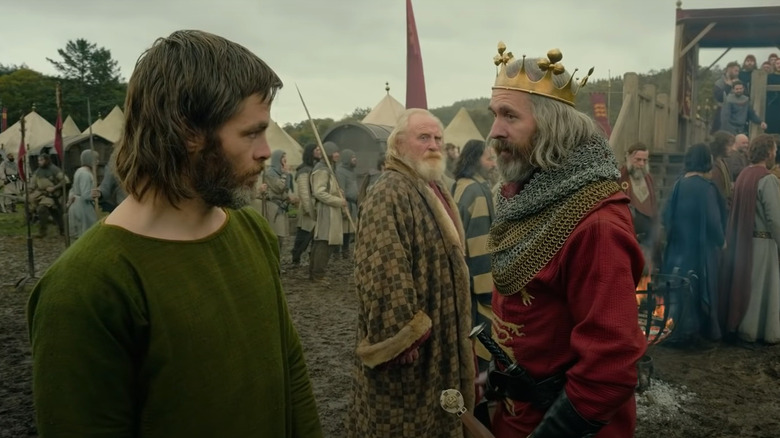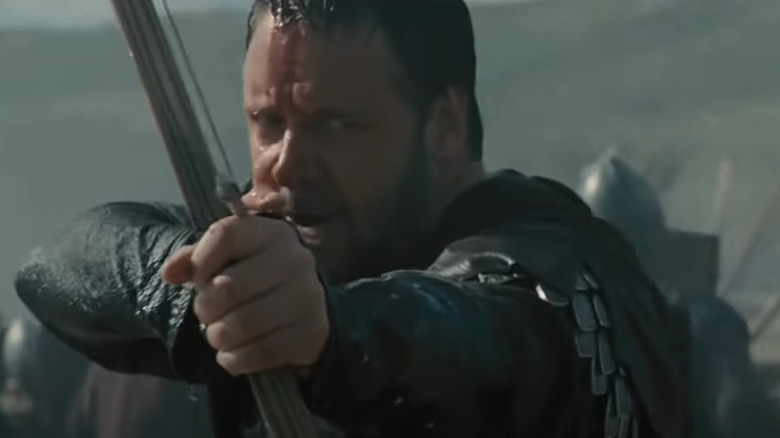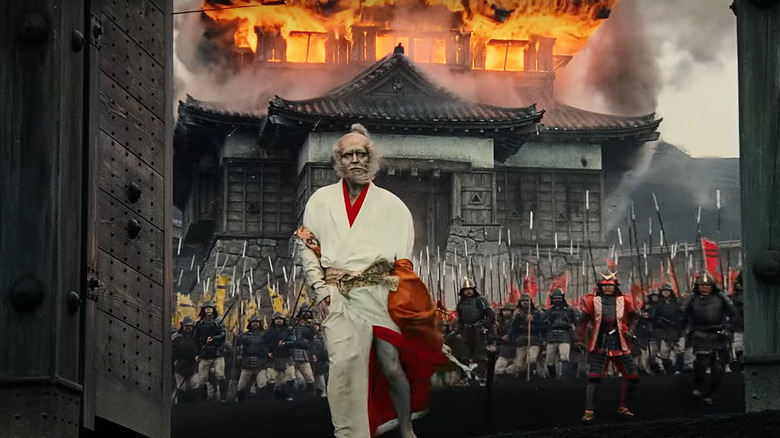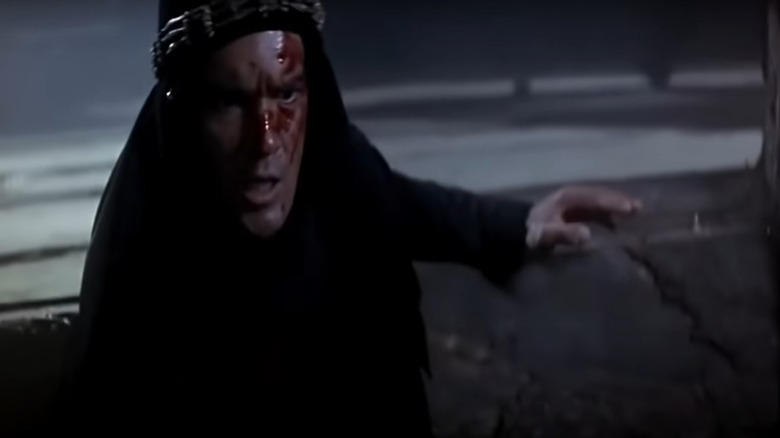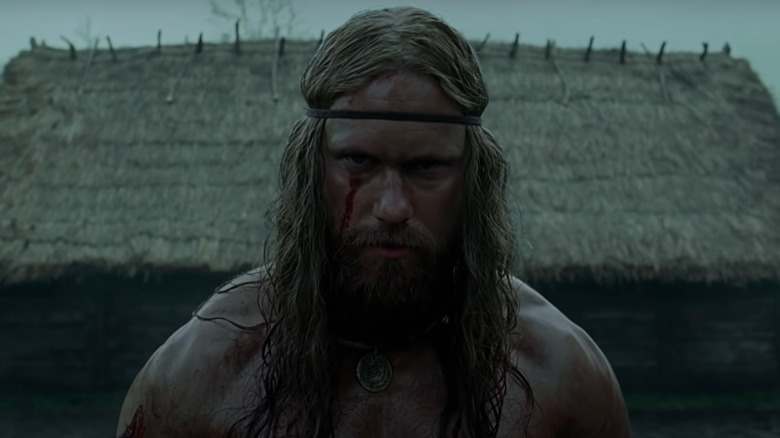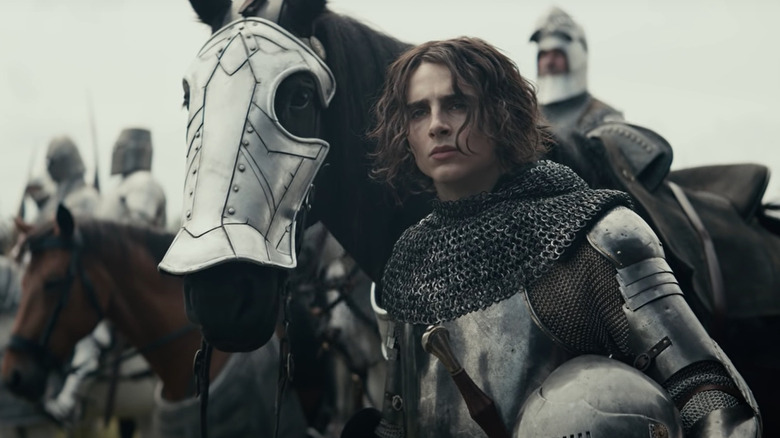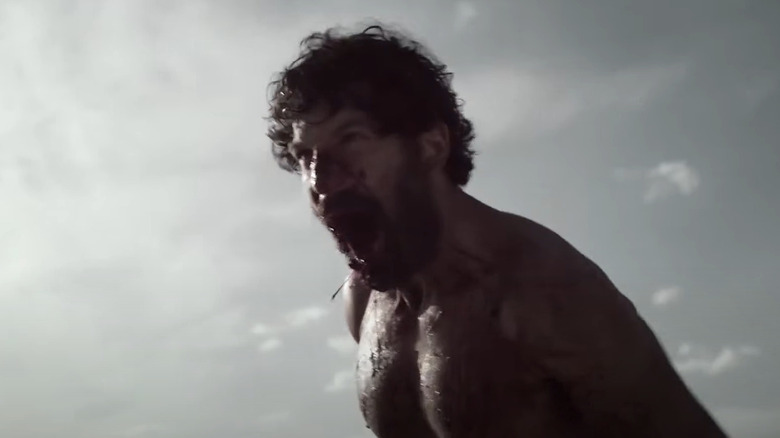25 Epic Movies Like 300 Everyone Needs To See
In 2006, an adaptation of Frank Miller and Lynn Varley's graphic novel "300" recreated the Battle of Thermopylae and banked over $456 million at the box office. While the film and its source material are not paragons of historical accuracy, their stylish interpretation of the legend around the battle immortalized its participants and launched Gerard Butler's action movie career.
It's hard to pin down exactly why the movie was such a success at the time of its release, but it has a lot going for it: Director Zack Snyder's visuals are striking, the trailer is awesome, and Butler looks really good in leather shoots. However, not all epics have done as well as "300" did upon its release. While it's always difficult to pin down what makes the box office explode and what makes it fizzle out, it's not too difficult to check out some epic movies cut from the same cloth as "300."
So for fans of sword-and-sandal dramas, grizzled historic thrillers, mythological mayhem, and movies where shirtless leading men pronounce words like they've been plugged into a loudspeaker, check out this list of 25 movies like "300."
300: Rise of an Empire
First on the list is the sequel to "300," "300: Rise of an Empire." Like its predecessor, "300: Rise of an Empire" was also based on a graphic novel from Frank Miller. The movie follows Athenian General Themistocles as he leads his people against the expanding Persian Empire. Like the original, the sequel is very stylish, leans heavily on slow motion, and plays fast and loose with history. Unlike the original, however, the sequel features naval battles. But not just any naval battles; it features naval battles done in the style of Zack Snyder.
With the patina of hyper-reality Snyder created in the first film, sequel director Noam Murro delivers a phantasmagoria of ancient oceanic warfare. Ships are the size of cities, men can jump dozens of yards, and arrows continue to "blot out the sun." It's really, really fun. The only person in the movie having more fun than the audience is actress Eva Green.
Green plays the movie's main antagonist and Xerxes' right hand woman, Artemisia. She murders his foes, leads his navy and keep his lackeys in line. She also steals every scene she's in. Clearly, Green relished the opportunity to play such a nasty villain in such a bonkers movie. Any fan worried that Butler's hammy energy could not be replicated in the sequel need not fear, Green is here. Avoid "300: Rise of an Empire" as a history lesson, but enjoy it as an expert display of unchecked insanity.
Troy
In the early 2000s, German director Wolfgang Petersen received a reported budget of $180-200 million to recreate one of humankind's oldest epics, Homer's "The Iliad," in a movie titled "Troy." To bring the timeless tale of Greece's invasion of Troy to the big screen, Warner Brothers and Petersen assembled a cast of Hollywood demi-gods that included Brad Pitt, Eric Bana, Orlando Bloom, Diane Kruger, Brian Cox, Sean Bean, Rose Byrne, Brendan Gleeson, Garret Hedlund, and Peter O'Toole. Yes, "Lawrence of Arabia" himself, Peter O'Toole, plays King Priam of Troy, and yes, it's amazing.
However, even with a mighty cast, an enormous budget, and one of the greatest pieces of source material that Classical literature has to offer, the movie didn't do so well upon release. Critic Roger Ebert wrote, "Homer's estate should sue," explaining that he felt "Troy" traded the elements of "The Iliad" that make it special — mainly direct interference from the Greek Gods — for "action movie cliches." While it's true that the movie does away with the gods' presence in the story, it's hard to accuse "Troy" of being cliche. Sure, it's not wholly original, but Pitt delivers a performance as Achilles that's ahead of its time, all pouty petulance and quiet regret that he's just so darn good at killing people. At the time it seemed like a bad thing, but today it's really worth checking out.
Gladiator
For fans of sword-and-sandal epics, there's no better modern take on the genre than Ridley Scott's "Gladiator." Scott, with a story from David Franzoni, made a movie about a Roman general turned slave turned gladiator turned champion of the people that's endlessly rewatchable. The movie holds up so well because it told a Golden Age of Hollywood tale with modern sensibilities. Instead of simply being a 1950s epic like "Ben Hur," "Gladiator" is also a revenge thriller and a sports movie all rolled into one.
The movie — for the unlikely few that haven't seen it somehow — follows the misadventures of one General Maximus Decimus Meridius, played by Russell Crowe. Maximus is a loyal servant of the Empire who's betrayed by the rising emperor Commodus during a coup. To seize power, Commodus accuses Maximus of murdering the previous emperor and sentences Maximus and has family to death. Eventually, Maximus ends up in the Coliseum as a gladiator and sees an opportunity to get revenge against Commodus.
What follows is an epic display of a lot of talented folks having an absolute field day in front of and behind the camera. The music swells, the swords fall, Hell is unleashed, and a young Joaquin Phoenix delivers one of the greatest villain performances of all time as Commodus. For anyone looking to be entertained by something similar to "300," look no further than "Gladiator."
Clash of the Titans
In the 1980's special effects pioneer Ray Harryhausen completed his magnum opus of visual effects, "Clash of the Titans." The movie would be remade without Harryhausen in 2010 and its poor reception with audiences is a testament to just how wonderful Harryhausen's practical effects really were. His amazing stop-motion creature designs are not only one of the reasons fans love the original, but also they give the movie a surreal vibe that CGI (wonderful as it can be) hasn't quite captured yet.
The film loosely follows the myth of Perseus, the illicit son of Zeus who's tasked to save a princess from movie monster hall of fame inductee the Kraken. The catch? The only weapon that can defeat the Kraken is the head of the Gorgon named Medusa. It's a charming action-adventure with some twists and turns provided by the scheming Greek gods and goddesses and their various agents.
The movie features a who's-who of old Hollywood stars, '80s marquee names, and legendary journeymen, including Harry Hamlin in the lead as Perseus, Burgess Meredith as the wise Ammon, Maggie Smith (Professor McGonagall in the "Harry Potter" films) as Hera, original Bond girl Ursula Andress as Aphrodite, and many, many more. It's a truly campy affair and well-crafted epic at the same time. For fans of the more hammy elements of "300," 1981's "Clash of the Titans" is appointment viewing.
Gods of Egypt
Alex Proyas' "Gods of Egypt” is an inherently silly movie. It stars Gerard Butler and Nikolaj Coster-Waldau as Egyptian gods Set and Horus respectively. It features CGI that can only be described as corny on purpose. But most importantly, it doesn't take itself seriously at all. Everybody involved in the film — from the director to the actors to the person who held the boom mic — knows exactly what kind of movie they're in. Line readings are winking and straightforward in equal measure, the story's stakes are so high they're simple to grasp even when the plot isn't, and Butler has a blast playing a villain who screams every line.
The movie — about the war between Horus and Set and the valiant human hero caught in the middle — is definitely an acquired taste. In fact, all of Proyas' movies are. Proyas' films largely lean into style and striking images to tell their stories. Sometimes his sensibilities result in marvelous wonders like "Dark City" and "The Crow." "Gods of Egypt" wasn't the biggest hit with critics upon its release. However, for any fan who enjoyed "300" because it was cool to look at, "Gods of Egypt" is the movie for them.
Immortals
The next entry on our list is a gaudy dip into formalism that contains some of the most unique visuals ever committed to the silver screen. It's called "Immortals" and it's awesome. A formalist film is a film in which the director consciously uses a number of different elements of filmmaking to create a clearly imaginary or heightened world on the screen. Like Zack Snyder did with "300" before him, director Tarsem Singh leverages a formalist approach to his film "Immortals."
The story follows demi-god Theseus and his quest to avenge his human mother after she's murdered by a violent king who's declared war on the Gods. However, the plot description doesn't do the movie's appeal any justice. Singh plays with color, set design, and camera work to create an ancient fresco come to life. In a promo for the film, Singh described his inspiration for the movie's aesthetic as a "painting strip." While its ambition doesn't always equal its results, it's more than worth checking out for the sheer thrill of seeing something you likely haven't seen before captured on the big screen. Anyone looking to be convinced need look no further than its opening scene.
Hercules
2014's "Hercules" is not a faithful adaptation of the myth or even a historically accurate recreation of the times in which the legend took place. Instead, a perfectly cast Dwayne "The Rock" Johnson plays a Hercules whose status as the son of Zeus is never confirmed nor denied. He brings the same shirtless energy to the character that Butler brought to Leonidas in "300."
In the movie, Herc is a well known entity in Ancient Greece who hires out his club — and band of mercenaries — to the highest bidder. He trades on his legend to make a buck, so the resulting movie plays like somebody threw "The Man Who Shot Liberty Valance" and "Clash of the Titans" into a blender. It's definitely an interesting idea for a film.
The film's also not hurt by its supporting cast. Hercules' band of merry mercenaries includes the always excellent Ian McShane of "Deadwood" and "John Wick" fame. The princess he serves is played by Rebecca Ferguson with the same kind of singular suspicion she brings to roles like the Lady Jessica in "Dune." Plus, incredible thespians like Joseph Fiennes and John Hurt show up in various heavy performances. It may not be faithful, but "Hercules" is most definitely fun.
Centurion
For anyone who felt the action in "300" was just a little too fantastical, look no further than "Centurion." The actioner directed by Neil Marshall, starring Michael Fassbender, Dominic West, and Olga Kurylenko, is a breathless sprint through ancient Britain with enough bone crunching and blood splattering to make any proud exploitation fan blush. The plot is simple: after surviving a massacre at the hands of the Picts, a small group of Roman soldiers attempts to escape the Scottish Highlands and get south of Hadrian's wall. Their only problem? They're hunted by the Picts' best tracker: The She-Wolf.
It's really primal stuff and director Marshall handles all of it with aplomb. His skill in helming a movie like this shouldn't be a surprise to anyone familiar with Marshall's work. He directed indie horror gems like "Dog Soldiers” and some of the best battle sequences in "Game of Thrones,” in episodes like "Blackwater" and "The Watchers on the Wall." In his hands, a B-movie premise is elevated to the highest reaches of genre filmmaking. Marshall knows how to turn a story from a dark corner of history into a chase movie in league with '70s fare like "Race with the Devil."
Alexander
"Alexander ” — Oliver Stone's meditation on history and one of its most impressive participants, Alexander the Great — is not quite a capital "G" great movie, but it's close. The story, like its namesake's vision, is beyond ambitious in scope. It follows the conqueror through the milestones of his life and the moments that inspired them. The shifting timelines can be a bit confusing for folks not versed in Classical history, but the movie is entertaining nonetheless, especially "The Ultimate Cut" issued by Stone in 2014. Critics like Peter Sobczynski, for example, have made a strong case that it's Stone's best version of the film.
While a movie with multiple cuts may not sound promising, "Alexander" is worth checking out. Stone — the man behind angry, brilliant anti-establishment films like "Platoon" and "JFK" — isn't the usual suspect to helm an epic. So instead of making a movie that praises the conqueror's achievements and recreates the defining moments of his life, Stone takes the time to display how much those achievements cost. In his hands, ancient history is a blood-stained, chaotic mess navigated successfully by the small few willing to make abysmal decisions. It's shaggy and overlong, but it asks real questions of its audience. For anyone interested in a movie like "300" that's about history and how it's told, look no further than "Alexander."
10,000 B.C.
For fans who didn't mind the historical anachronisms of "300," this next entry is for you. "10,000 B.C." is tons of fun, but by no means is it a solid representation of primordial life on Earth.
The movie follows a Yagahl tribesman named D'Leh, played by Steven Strait, and his quest to rescue his wife, Evolet, played by Camille Belle. Over the course of his journey, D'Leh encounters mammoths, terror birds, and a sabre tooth tiger, which would be awesome enough on its own. However, it gets even better because the film was directed by Roland Emmerich. Emmerich — probably best known for the all-time classic "Independence Day" — makes movies like '80s metal bands made albums: They're loud, they're zany, they're a bit weird, and they're so much fun to jam too.
In one signature Emmerich action sequence, D'Leh frees enslaved tribesmen from their ruthless captors by causing a wooly mammoth stampede down the side of a pyramid. Emmerich, in his trademark fashion, does a good job making the CGI mass of mammoths come off like the force of nature they probably were. In other words, who needs weapons when there's a bunch of six-ton mammals running down a hill into traffic. Is it silly? Of course. But it's also a great time.
The Eagle
Our next entry stars Channing Tatum and Jamie Bell as a Roman soldier and a captive slave on a mission to restore the lost signet of their legion: The Eagle. In his review, critic Roger Ebert called the movie a "rip-snorting adventure." He then went on to explain he felt that he had to "bring the term 'rip-snorting' out of retirement" because they don't make many swashbuckling adventure stories anymore. They really don't.
Tatum and Bell make a great team and the movie wisely does more for their relationship than simply turning them into a buddy comedy duo. Instead, the film leans into the pair's uneasy alliance. Bell's slave Esca hates the Roman Empire but feels loyal to Tatum's Marcus because Marcus saved Esca's life. It's well-developed, well-acted, and it adds an uncommon wrinkle to a plotline that otherwise may have veered into cliché.
On the action front, the movie keeps things pretty pared down. Not to say there's no action — there's plenty — but rather their fight scenes rely on practical effects, editing techniques, and actual human bodies over mass formations of CGI. While not nearly as stylized as the balletic battles in "300," the straightforward approach to combat in "The Eagle" gives the movie a hard edge that's definitely worth checking out.
Kingdom of Heaven: Director's Cut
For folks who enjoy their film epics long, their heroes conflicted, and their battle sequences taking screen time in the double digits, look no further than Ridley Scott's "Kingdom of Heaven: Director's Cut." The movie tracks the exploits of Orlando Bloom's Balian, a French blacksmith who joins the Crusades to seek redemption for his wife taking her own life.
The movie suffered a backlash for its attempts to modernize the conflict of the Crusades to reflect Scott's own feelings about ongoing contemporary wars in the Middle East. For example, The Guardian's Alex Von Tunzelmann gave the movie a "C –" for its historical accuracy in his review. However, the movie is "A" for awesome.
Scott builds "Kingdom of Heaven" like an enormous epic from a bygone era. There are multiple characters competing over conflicting motivations, villains ranging from the opportunistic to the outright evil, and enemies who make good friends. If all that wasn't enough, it also contains one of the greatest battle sequences of all time: When Saladin's army arrives to take Jerusalem from the Crusaders in the third act, the film ascends into epic movie Valhalla.
There are siege towers, battering rams, flaming arrows, catapults, hundreds of extras, and some human drama sprinkled in for good measure. Plus, through Scott's capable lens, the audience will never lose their place on the battlefield. Any fan taken by the astonishing spear slinging of "300" will marvel at the climatic battle of "Kingdom of Heaven."
Spartacus
1960's "Spartacus" is widely considered an all-time great movie — and it's not hard to see why. It stars the platonic ideal of Hollywood's leading man, Kirk Douglas. It was written by Dalton Trumbo, a screenwriter so talented there's a movie about him. It's filled with a kaleidoscope of working Golden Age character actors, including John Ireland, Charles Laughton, and the incomparable Woody Strode. And last but not least, it was directed by Stanley Kubrick. Yes, that Stanley Kubrick.
The movie, for the uninitiated, follows the relatively straightforward story of Spartacus' enslavement by the Roman empire, his time as a gladiator, and his subsequent slave rebellion against the Romans. However, while its narrative beats may be standard fare, the rest of its components are far from it. Douglas' central performance radiates charisma. Trumbo's screenplay invented classic moments like the "I'm Spartacus" sequence that have been copied but never outdone since. Kubrick's genius shines through in scenes he frames marvelously or stocks with extras to give the movie its genuine epic depth and scope.
Another movie like "Spartacus" probably won't come along ever again, but for acolytes of New Testament swordfests like "300," consider "Spartacus" the Old Testament. It's absolutely worth streaming wherever it's available.
Conan the Barbarian
In 1982, Arnold Schwarzenegger and director John Milius brought "Conan the Barbarian" to the big screen. The movie, inspired by pulp author Robert E. Howard's character of the same name, is a bloody, early-'80s romp through the sword-and-sorcery genre. Conan, brought to musclebound life by Arnie himself, is a pretty simple barbarian. He's enormous, good at sword fighting, and believes the three greatest things in life are: "To crush your enemies, to see them driven before you, and to hear the lamentations of their women."
However, the movie surrounding Conan is not so simple, and that is its genius. In any other fantasy movie, somebody like Conan sets out to slay a monster or find some treasure. But not Conan. Instead, he's tasked to assassinate a hedonistic cult leader who can turn himself into a giant snake.
Is the cult leader played by James Earl Jones (the legendary voice of Darth Vader)? Yes. Does their religion revolve around feeding people to giant snakes? Absolutely. Were the '80s the best time for crazy ideas on the big screen? Hard to say, but probably.
While the bonkers attitude of "300" turned the volume up to 11, "Conan the Barbarian" blew up the amp entirely. So for fans of the beautifully ridiculous, do yourself a favor, pray to Crom and fire up "Conan the Barbarian."
Conan the Destroyer
The sequel to "Conan the Barbarian," called "Conan the Destroyer," brings the same high fantasy and striking visuals to the big screen that its predecessor did. However, this time it adds ritual prolicide, a quest for a mythical horn, a fight in a hall of mirrors, some stop-motion monsters, and NBA superstar Wilt Chamberlain.
There's a lot more to the movie, but to give away too many of the plot's details would spoil the fun. Needless to say, any movie with Wilt Chamberlain playing a warrior named Bombaata is a must-watch. The man scored 100 points in a single game and wields a mace in a 1980s fantasy movie. Beyond Wilt's contributions to cinema, the movie also features Grace Jones as Zula and Olivia d'Abo (of "The Wonder Years'" fame) as Princess Jehnna.
The movie, rated "PG" instead of "R" like its predecessor, is significantly less violent than the first film. However, its milder take on the character is overridden by the sheer fun the actors are having on set. For any fan looking to enjoy some quirkier fantasy without the accompanying violence, "Conan the Destroyer" is for you.
Ironclad
"Ironclad" has a lot going for it. Like "300," it depicts a grisly stand off between a small fighting force and an enormous invading army. Also like "300," it uses a single moment from history as an excuse for actors to chew scenery and stab things. It's brilliant.
"Ironclad ” recreates the time period following King John's forced approval of the Magna Carta. To simplify a chunk of history: King John's lords were fed up with his tyrannical behavior and made him sign a contract guaranteeing a uniform rule of law in England. After signing, John kicked off a civil war to regain the power he lost when he signed the Magna Carta. The film depicts one battle from this war, the Siege of Rochester. It's not an accurate depiction of the event by any means, but it's a really fun watch.
Ever since "The Seven Samurai," movies about groups of warriors on a near-hopeless mission crop up at the box office every few years. Luckily for fans, it's an amazing subgenre. In this version of the tale, James Purefoy, a warrior monk, leads a ragtag group of fighters against Paul Giamatti's King John. Giamatti turns every appearance on screen into a five course meal and at one point a man is executed by being launched out of a catapult. This is definitely the "300" version of history and it's most definitely worth checking out.
Valhalla Rising
2009's "Valhalla Rising" is more of a fever dream than a movie. Director Nicolas Winding Refn's insane Viking film stars one of the greatest character actors of all time, Mads Mikkelsen, as One Eye. One Eye is a mute warrior who's really, really good at hurting people. After escaping a life of captivity where he fought for the entertainment of his captors, One Eye accompanies some Christians on their Crusade. Saying anymore than that would spoil the movie's greatest surprise.
What won't spoil the film is talking about the stylish way Refn does, well, everything. Like "300" director Zack Snyder, Refn's works have a look that's all their own. In other words, anybody who recognizes the director's work will likely know when they're watching a Refn movie. Refn's stylistic choices lean heavily on extreme color contrasts, graphic violence framed artistically, and protagonists who don't speak all that much.
Luckily for Refn, and fans, Mikkelsen doesn't need to say a word to communicate how dangerous his character is. He's so good in the role, it'll be hard to not see One Eye the next time fans see Mikkelsen on screen. For anybody looking for another film about combat that pairs a charismatic lead with a super-stylish director, check out "Valhalla Rising."
Braveheart
"Braveheart," directed by and starring Mel Gibson, follows the life and times of William Wallace, the medieval Scotsman who led a rebellion against the oppressive British. It was enormously popular upon its release. In fact, "Braveheart" grossed $209 million worldwide during its initial run and went on to win Best Picture, Best Director, Best Cinematography, and more at the 1995 Oscars.
Its success lies in Gibson's ability to quickly humanize characters onscreen. Under his direction, the almost mythic rebellion Wallace leads becomes rather simple. Wallace falls in love, marries, and the British kill his wife. In retaliation for her murder, Wallace leads a country of disparate clans to the brink of freedom — it's rousing stuff. While it certainly didn't invent the inspiring movie speech, Wallace's address to the Scots before the Battle of Stirling is an all-time classic.
The movie also features a memorable villain in the ever-crooked King Edward Longshanks and a host of supporting rebels with wonderful one-liners. While "300" and "Braveheart" are stylistically extremely different, they are spiritually related. Recommended to any fan who enjoys their sword slashing served with a side of big emotions.
Outlaw King
2018's "Outlaw King" serves as a spiritual follow-up of sorts to "Braveheart." The movie, set in medieval Scotland at the end of William Wallace's failed insurgency, traces the rebellion of Robert the Bruce. Bruce, played by Chris Pine, is a highborn lord who breaks his alliance with England in a bid for the throne of Scotland and the country's independence. His war with the English is long, arduous, and costly.
While all of this may sound like standard historical sword-swinging fare — or just another "dad movie" — director David Mackenzie films the movie with such grace that some scenes play more like arthouse than epic. For example, in the opening scene Mackenzie introduces the conflict, its major players, and the character of the film's protagonist in an enormous single tracking shot. In an interview with Collider, Mackenzie explained he wanted to "throw the audience into the world."
It works. For the rest of the movie Mackenzie and his cinematographer Barry Ackroyd compose scene after scene of tactical beauty. For the audience, it makes the alien time period feel much less foreign because it gives every shot depth, reality, and sense of lived-in-ness. Frankly, no movie about Dark Ages bloodshed has any business looking this good. For fans taken by the unique version of beauty in "300," this one's for you.
Robin Hood
Robin Hood is a character from British folklore who's remained in the cultural zeitgeist for an impressive 700 years since first appearing in the 15th Century. Since his inception, he's appeared in stories and movies across the decades. This is director Ridley Scott's take on the legend and, for readers keeping track, Scott's third appearance on the list.
In his hands, Robin Hood, played by Russell Crowe, is a lot like Maximus from "Gladiator." He's a skillful but reluctant warrior, who leads a groundswell uprising against a tyrannical ruler. However, this being a Scott movie, the director ditches a lot of the whimsy wrapped up in Robin's legend for a tale about men battling the Crown. He ropes in the Crusades, the signing of the Magna Carta, and a subplot about English knights colluding with the King of France.
Those not versed in medieval history may find the plot a bit convoluted. But anybody clambering for more Russell Crowe speechifying, bow shooting, and swordplay will not be disappointed. Also, Friar Tuck stans, have no fear: Scott keeps him around for some charming moments of comic relief. "300" took historical figures and made them mythic beings; 2010's "Robin Hood" takes a hero from legend and grounds him in reality. It's a fun watch.
Ran
Akira Kurosawa is an incredible director. Entertainment Weekly even placed him on a list of the greatest directors ever. For anyone interested in his work — or seeing "300"-sized battles created without CGI — seek out "Ran."
"Ran" adapts the basic plot of Shakespeare's "King Lear," but transplants the story to feudal Japan. In the story, an aging warlord divides his land among his sons instead of choosing a single successor. Naturally, the sons almost immediately fall into bitter infighting over who controls what. If Shakespeare with samurais isn't enough of a selling point, the movie's almost life-sized battle scenes should do the trick.
Since "Ran" was made in 1985, Kurosawa opted to film his war sequences at scale with armies composed of real actors. Most battles are fought by armies in opposing primary colors, while practical effects like smoke and real sets make up the rest of the palette. The end result is a movie so beautiful it's hard to look away from — even when it turns tragic. Kurosawa's visuals are magnificent, but they're not solely about war. Instead, they make up one of the greatest movies about the perils of ambition, legacy, and existentialism ever put on the silver screen.
The 13th Warrior
1999's "The 13th Warrior," is an action movie from the mind of Michael Crichton. Crichton wrote "Eaters of the Dead," the book that the movie was based on, along with other famous novels like "Jurassic Park." In the film, as in the book, Norse Vikings are sent on a quest to defeat man-eating monsters known as Wolden. The catch is that they have to bring a non-Viking warrior along or their quest will fail. Enter the 13th warrior, Ahmad ibn Fadlan, from the court of the Abbasid Caliphate in Baghdad.
While the movie's central casting decision — Antonio Banderas plays Ahmad ibn Fadlan — has not aged particularly well, the rest of the film is a well-crafted "men on an ancient Viking mission" movie. On top of an engaging story, the movie was helmed by action directing legend, John McTiernan, whose resume reads like a highlight reel of the genre and includes both "Die Hard" and "Predator."
This movie, like "Predator," injects elements of horror into its action formula since its antagonists are cannibals who strike under the cover of fog. It's a bit grisly, but it's also very, very entertaining. Anybody interested in spending more time with villains like the mystical Immortals of "300" should check out this flick.
The Northman
Zack Snyder's "300" is remembered for rendering an ancient conflict through highly stylized cinematography and design choices. Robert Eggers' "The Northman" will likely be thought of for the same reasons. However, unlike Snyder, Eggers has rooted his singular production design in painstakingly accurate period detail and based his cinematography in long, single camera shots. Both of Eggers' choices make "The Northman" unlike any movie in recent memory.
Through his lens, the Scandinavian legend of Amleth (which Shakespeare adapted to "Hamlet") is a pulsating, living, breathing, heaving, and bleeding thing. It's a visceral exercise in creating a world long lost to history, so that his actors can run, stab, chop, vomit, flatulate, and fornicate their way through it. The movie acts as a bizarro portal to a point in human history when glory, honor, and death by the sword were the guiding principles of life. It should feel alien to watch, but "The Northman ” is so specific in its telling that it almost makes its characters' horrendous actions understandable.
The movie also features one of the greatest single-shot battle scenes ever committed to the screen, big or otherwise. If anybody ever asked for coverage of a berserker raid with a camera that operates like it's covering a football game as opposed to a movie, look no further than "The Northman."
The King
Timothee Chalamet's "serious actor" coming-out party, titled "The King," is a must for fans who like to get into the historical muck. The movie updates Shakespeare's history, "Henry the IV Parts 1 and 2," for modern audiences. In doing so, it follows Chalamet's Prince Henry from reluctant ruler, party boy, and layabout to serious king who battles France.
What sets "The King" apart from other historical dramas is its insistence on muddling Henry's ethics. Plenty of movies deliver scenes where knights bump helmets and touch swords, but "The King" takes time to examine why they're doing it and who benefits from it. What follows is an interesting meditation on the pitfalls of leadership, weighty decision making, and why war boils down to the will of the few, not the many.
If any of this sounds a little modern for a medieval movie, it is. However, this modern evaluation of the legend of Henry IV makes the movie more interesting. It also offers some connective tissue to a movie like "300," which was imbued with a modern focus on fighting for democracy. Anybody who enjoys their knights served with a heady brew of philosophizing about the nature of power, check out "The King."
Pilgrimage
"Pilgrimage" follows a group of monks on a brutal trek across medieval Ireland in an effort to deliver a holy relic to the Pope. It also features a cast of now A-list actors like Tom Holland and Jon Bernthal. The movie, directed by Brendan Muldowney, follows the "Apocalypse Now" or "Heart of Darkness" storytelling model.
The monks, set in their ways and beliefs about the Church, face increasingly bizarre, dangerous, and violent scenarios on their journey, with various different parties interested in the relic. By time they reach their final destination, the group (mild spoiler) has changed. Holland plays Brother Diarmuid, a young, fresh-faced monk who's never left the monastery. Bernthal plays "Mute," a monastery laborer who doesn't speak and seeks redemption for the heinous sins he committed as a knight in the Crusades.
While some of the ideas in the movie are not particularly fresh, its unique setting creates opportunities for all kinds of dips and dives into some of medieval history's truly chaotic elements. For example, the presence of Gaelic tribes stand in for the colonized peoples in stories like "Heart of Darkness," while mounted knights replace the helicopter battalions famously captured on film in "Apocalypse Now."
Plus, for fans of "300"-style action, Bernthal delivers as a shirtless bruiser of a bodyguard who's as talented with his fists as he is with a sword. The movie went under the radar upon release, but it's certainly worth tracking down now.
